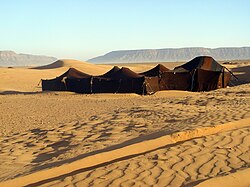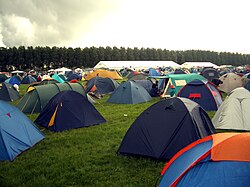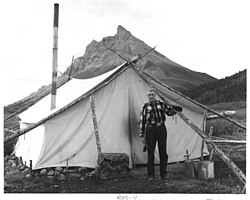Tent
A tent is a movable, lightweight shelter which uses fabric to protect people from wind, rain and from the cold. The fabric walls of a tent are supported by wood or metal poles and thin ropes (called "guy lines"), and the tent or the ropes are usually attached to the ground with plastic or metal pointed stakes, or lattice frames and internal posts in the cases of yurts and marquees. Tent camping exploded in popularity in the 1960s. Manufacturers introduced poles made of fiberglass or aluminum alloys, allowing for a greater range of shapes and a lighter weight tent to transport. Zippered tent doors replaced the traditional flap opening.[1]
Uses
Tents are usually used as shelter during camping, hiking, and other outdoor recreational activities.[2] Large tents are also used to provide temporary shelter for events such as outdoor weddings or circuses. Tents are also used to provide temporary sleeping quarters for military personnel or homeless, or for people who have been displaced by a disaster (such as refugees).
Tent Media
A Berber tent near Zagora, Morocco
Detail of an early 18th-century tent in the District Museum in Tarnów in Poland, richly decorated in Muslim motifs and equipped with windows – an example of luxury tent-making for the Polish–Lithuanian Commonwealth's magnateria.
Junjik Valley man and wall tent. Picture from the U.S. Fish and Wildlife Service, July 1973
References
- ↑ "A Brief History of Tents - where did tents originate? The History of Tents". www.turas.tv. 2018-07-14. Archived from the original on 2022-03-02. Retrieved 2022-04-21.
- ↑ "How to Put Up A Tent".











